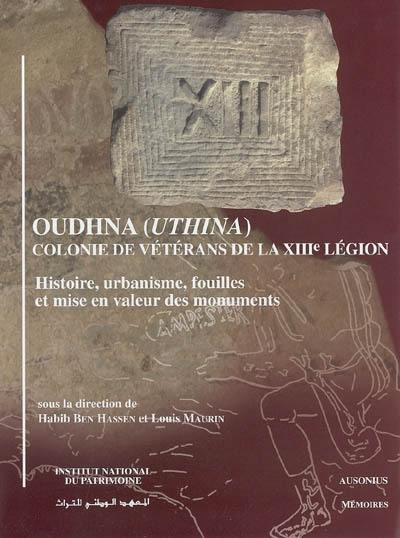
Fiche technique
Format : Relié sous jaquette
Nb de pages : 278 pages
Poids : 800 g
Dimensions : 22cm X 29cm
EAN : 9782910023539
Oudhna (Uthina), colonie de vétérans de la XIIIe légion
histoire, urbanisme, fouille et mise en valeur des monuments
Quatrième de couverture
Six ans après la publication d'Oudhna (Uthina), la redécouverte d'une ville antique de Tunisie, un nouveau volume est consacré à cette colonie augustéenne; il donne les résultats des recherches archéologiques qui ont été poursuivies de 1998 à 2001 afin d'approfondir les connaissances sur le site et de préparer sa mise en valeur.
Comme le précédent, il comporte sept chapitres, suivant les mêmes thèmes. L'histoire de la colonie est enrichie à travers de nouvelles inscriptions où une attention particulière est portée aux noms de la fondation romaine. L'étude de la topographie générale du site a été achevée, illustrée par une riche série de plans commentés. Sont présentés ensuite deux monuments sur lesquels les recherches ont plus spécialement porté durant ces dernières années, le capitole et l'amphithéâtre; les remaniements parfois considérables qu'ils ont connus sous l'Empire sont mis en évidence, et l'on peut proposer une restitution complète de chacun d'eux; un important dossier épigraphique accompagne l'étude de l'amphithéâtre.
A partir de nouvelles prospections archéologiques le long des aqueducs qui alimentaient la ville sont dégagés les caractères très originaux du réseau qu'ils constituaient. Avec un lot de céramiques provenant d'un milieu clos est donnée une nouvelle approche de la production des nombreux ateliers qui ont été très actifs dans l'Antiquité tardive, tandis qu'un aperçu sur la céramique islamique découverte à Oudhna ouvre des perspectives sur l'occupation du site après la période byzantine. Pour finir, un chapitre replace Uthina dans son environnement géographique et dans l'histoire de l'occupation du sol à l'époque romaine.
Six years after the publication of Oudhna (Uthina), la redécouverte d'une ville antique de Tunisie, a new volume continues the work on this Augustan colony; it gives the results of archaeological research that was conducted from 1998 to 2001 in order to deepen the knowledge of the site and to restore and display its true worth.
The book follows the same themes as the previous one through seven chapters. The history of the colony is enriched with new inscriptions where a special attention has been given to the names of the Roman foundation. The topographical study of the ancient agglomération has been completed and is illustrated by many abundant annotated maps. Then, two monuments on which the investigation was especialy focused during the last few years are presented, the capitole and the amphitheater; the changes they underwent under the Empire are highlighted and a complete restitution for each of them is proposed; numerous epigraphic documents accompany the study of the amphitheater.
The originality of the aqueduct network that fed the ancient town was revealed after new archaelogical prospection along this one. A ceramic hoard coming from a sealed area gives a new idea as to the production of the various workshop which were very active during late Antiquity, whereas an overview of the Islamic ceramics discovered at Oudhna opens new perspectives on the occupation of the site after the Byzantine period. Finally, a chapter places Uthina in its geographical environment and within the history of the ground occupation at the Roman period.





